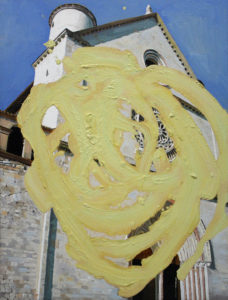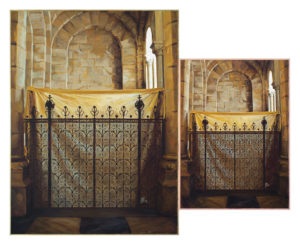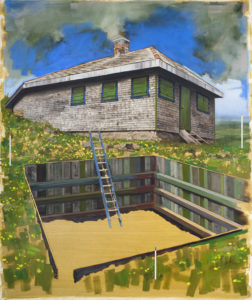JONATHAN ANDERSON THINKS ABOUT his paintings in construction terms: to him, they are buildings. They regularly depict architectural structures—façades, doorways, hallways, stairways, chapels, homes, and so on—structures in which people live, move, and interact. But his paintings are not only images of built structures; they also are themselves built structures, material constructions that create space for the kinds of human dwelling associated with slower, reflective vision. As Anderson points out:
The enduringly strange and wonderful thing about images is that they offer this space on flat surfaces. A painted image opens out onto things-in-the-world other than itself, while always remaining its own distinct thing-in-the-world—a flat painted object in the same space as my body. The painting simultaneously offers access to something other than itself and withholds it, and it is the materiality of the surface that performs both functions.
Scrutinizing the implications of this twofold offering-and-withholding, the art of Jonathan Anderson is somehow both hospitable (in George Steiner’s sense, as in Real Presences, where he argues for a hermeneutic of courtesia or intellectual hospitality on the part of the reader or viewer as well as on the part of the text and author) and at the same time seems to disallow entry. Since he finished his MFA in 2004, most of Anderson’s paintings have in one way or another simultaneously opened realistic visual spaces and set up roadblocks into the pictorial structure of these spaces, reminding the viewer graphically of the objecthood of the image—a canvas or panel covered with paint from edge to edge. The various obstructions, abstentions, and gestural marks in these works act as a kind of stop sign or caution barrier, precluding entry into the illusion of 3D space on the 2D surface. In a word, these paintings refuse unselfconscious entry into the world of the image.
Anderson’s Impasse series consists of carefully constructed traditional “realist” landscapes and architectural spaces impeded by obstructions, repetitions, and absences. The earliest paintings in the series—Freezer (2005), Celestial (2005), and Foundation (2005)—are large paintings of dead ends and barricaded passageways, pictorial spaces that seem open and closed at the same time. Curtains (2006–7) pushes this experience further in its portrayal of a chapel undergoing renovation, which the artist encountered in Spain [see Plate 4]. The chapel is full of light but is empty and inaccessible, blocked not only by the scrolling ironwork of the closed gate but by a makeshift curtain propped behind it. Another, more profound barrier arises from the fact that Anderson repeated the painting, painstakingly “attempting to speak the encounter again” at a smaller scale, and then bolted the two images together into a single work. As the artist says:
There’s a strange effect that happens when a person speaks a phrase and then immediately repeats it. One’s attention suddenly shifts from the content of the communication to the medium—the sounds and inflections, the grammar, the social norms—all these become conspicuous in the repetition though they were more or less transparent upon first usage. I’m interested in how a painting might do something similar visually. In the singular image one encounters a chapel, but once it is doubled, our experience becomes one of shuttling between the two chapels as images.
Mechanical and digital repetition is fast and ubiquitous in contemporary art, whereas the repetition of Anderson’s Curtains is slow and intensely manual, formed through the inefficient labors of observational painting. This same labored repetition is explored in several other works in the series, including Suspension (2007–8), Protraction (2008), Long (2008), Theoria (2009), and Ology (2006–9).
The title piece of the entire series is the small painting Impasse (2007), which appears to be a ruined painting: a careful representation that has been scribbled over with an emphatic graffito-like defacement [see Plate 1]. But this “defacement” is in reality the beginning point of the painting: the spiraling yellow brushstroke was the first mark made on the blank wooden panel, and then the image (portraying the façade of the Basilica of Saint Francis of Assisi) was painstakingly painted around and between this initial gestural scribble. The yellow tangle creates a barrier to the illusion of depth, but it is not applied over a finished image; there is only a single layer of paint. In Anderson’s words:
There are two orders of mark-making set alongside each other here, each corresponding to a different visual logic—one pertaining to the flatness of the material surface and one to the pictorial depth and volume portraying the basilica. We experience these two logics as competing with one another, even effacing each other, but I’m interested in the ways that they reveal each other as different orders of meaning.
Exploring this same procedure in several other paintings—Ways and Means (2007) [see front cover], Contraction (2007), Headstone (2007), Def (2007), and, later, Fountain (no. 1) (2012)—Anderson enacts a simultaneous opening and closing of the “magic window” of the representational image.
In an interview, he said:
I don’t really think of these images as arising from negative refusals as much as from competing positive affirmations. These paintings attempt to simultaneously affirm the pictorial function of the painting-as-image and the material given-ness of the painting-as-object. And, in fact, I’m interested in making paintings in which both of these affirmations are as conspicuous as possible, such that our attention oscillates between these two ways of seeing the thing as meaningful.
In other words, Anderson is not so much interested in merely denying access to the illusionary depth of depicted objects as he is drawn to the question of how the material and representational realities of a painting coinhere. Like his paintings, Anderson’s thought occupies a liminal position in the fray between traditional representational painting and the abstemious space of conceptual art:
I was trained as a realist painter, but I think more like a conceptual artist. The paintings always feature representational imagery, but my decisions in the studio are pushed forward by fairly simple conceptual procedures that are oriented toward bigger issues. The better question to ask in front of most of my work is not “what does this depict?” but “what does it mean to do this?”
Anderson points to at least two contexts that inform his work and motivate him to pursue the stop-sign effect of the painterly splashes that obscure the meticulous image of a beautiful building or landscape. On the one hand, his paintings situate themselves in relation to photography. Not only does he often rely on photographic references in making these paintings, he is also highly conscious of the ways their repetitions and pictorial interruptions operate in a photographic visual culture:
When photography was invented, painting was pushed into an unavoidable identity crisis: it had to figure out what it was now for, what it might offer the world once visual representation is predominantly mediated photographically. But the flipside of this crisis is that painting was also released from having a primarily pictorial function. The range of possibilities is now wide open for what a painting is and how it might work.
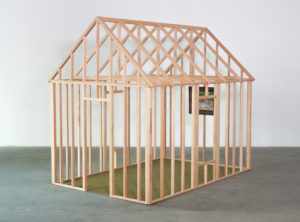
PLATE 2. Jonathan Anderson. Construction (after Thoreau), 2011. Wood, oil on panel, and acrylic on canvas. 84 x 90 inches.
In other words, once we could perfect verisimilitude of images by mechanical means, artists were set loose to explore the very ground of image-making itself. One simple way of thinking about the stop-sign effect in Anderson’s work might be the recognition that these paintings engage in a kind of critical realism: they offer images of our world that are recognizable to us in pictorial depth at the same time as they insist upon the physicality and constructed-ness of their painted surfaces. As he says, “One of the things a painting might do in a photographic culture is to explore, perhaps even cultivate, more self-critical ways of looking at images. And this is important, because it gives us opportunities to think more slowly about how images mean and about the remarkable fact that images mean in the first place.” And so he makes works that simultaneously offer and withhold representations of reality—much like the problematized speech-act that literary theorists have been discussing for a half-century.
On the other hand, Anderson also points toward a philosophical and theological substrate in his works. Several of his Impasse paintings depict religious spaces—chapels, churches, graveyards—linking his meditations on representation to long traditions of theological reflection on these same issues. As he says:
Despite the sometimes arcane ways I talk about them, my paintings are really not intended to simply be visual riddles or a navel-gazing “art about art.” They are attempts to encounter the sheer givenness of the world and to sensitize myself to how the world is intelligible, how it is “sayable” and representable—and, for me, these inevitably give way to theological questions.
Anderson’s thinking about the sayable and unsayable draws from various theological traditions. From one direction, his work is informed by a Protestant visual-theological heritage. For instance, discussing his work, he points to the way that Protestant theorists turned artists toward the world of everyday phenomena—in Calvin’s words, toward that “which the eyes are capable of seeing”—as the domain of God’s grace and as a domain of artistic responsiveness. Anderson argues, “This shifted the center of weight for where and how visual theology operates in the modern era in ways that are fundamental to the development of modern art.”
From another direction, Anderson’s work is also influenced by the apophatic traditions in Christian theology, which proceed from the understanding that no human category—even the most capacious categories like “Being” or the most developed doctrines of God’s transcendence and immanence—can finally contain, exhaust, or manage God’s infinite otherness and infinite fullness. As Anderson makes clear, “Apophatic theology is not oriented toward the negation of our language about God but toward the failure of our language about God.” This tradition in no way attempts to steer believers into total silence, negation, or loss of faith—or heterodoxy. Rather, apophatic theology engenders an epistemic humility and a proper reticence with regard to the propensity of human reasoning and rhetoric to reduce God to a metaphysical object (one kind of thing among other kinds of things). Anderson follows the implications of this thought into visual language:
The apophatic impulse in my work is ultimately not about negation but about the failure to affirm the fullness of being and the fullness of the one who gives all things their being. On an intellectual level, these paintings are about the limits of representation; on an affective level, they articulate a certain kind of longing. That is probably the deeper, more important level.
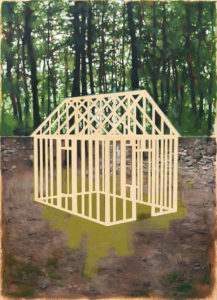
PLATE 3. Jonathan Anderson. Construction (The Clearing), 2011. Oil on joined birch panels. 66 x 48 inches.
The trajectory of Anderson’s Impasse series is somewhat different than that of his series Constructions, where the metaphorical link between painting and architecture becomes especially loaded. Many of the paintings in this series conflate the construction of an image with the construction of a home. In Construction (no. 6) (2009), for example, the structural framing of a half-built house is painted negatively, such that the wooden studs and beams are in fact unpainted omissions in the pictorial landscape, revealing the bare wooden panel on which the painting is constructed. This gap in the image, a caesura of sorts, reveals the wood grain of the panel underneath, but the form nevertheless has qualities of illusionistic rendering of great precision—with perspective lines fastidiously reproducing the three-dimensional framework of a building site, even though it’s completely unpainted. The sum effect of this method is, according to the artist, that “the wooden figure in the image is materially equivalent to the wooden ground of the painting itself: the figure reveals the ground, and the ground shows itself as a figure.”
These figure-ground conflations create subtle rifts in the visual language of these paintings, generating at least two competing ways of seeing them. Within the pictorial logic of traditional representational painting, these negatively painted structures appear as absences: unpainted voids in the pictorial space. From another point of view, however, these areas of unpainted panel are stronger material presences than the illusionistic imagery of the surrounding landscapes. Both frames of reference—painting-as-image and painting-as-object—are entirely appropriate to understanding what each painting is, even though they produce seemingly inverse conclusions. In this way, these works mull over the problems of representation and the enterprise of constructing our understandings of reality. In several instances—Constructions no. 4 (2009), no. 7 (2009), and no. 10 (2012)—the landscape is visible through the built structure. They are about nature, the built environment, and questions surrounding our interventions in the natural world; but they are also about how we make sense of things.
For the sculptural work Construction (after Thoreau) (2011), Anderson built a half-scale model of the cabin that Henry David Thoreau constructed at the edge of Walden Pond [see Plate 2]. This scaled-down house frame is presented as a structural skeleton with no “skin.” Within its naked interior is hung a traditional framed painting of a forest, depicting the view from where Thoreau’s cabin once stood. At exactly half the size of the original building, this house is abstracted from functional living space and instead appears as a kind of thought-model (or perhaps a child’s playhouse), as if the artist were inviting us into the space of an idea and equating that invitation with Thoreau’s invitation into the woods to retreat from the built environment.
In Construction (The Clearing) (2011), Anderson turns this procedure inside-out by negatively painting this reconstructed house frame back into the Walden landscape where the original cabin was located [see Plate 3]. The parenthetical title of the work subtly invites Thoreau’s project of deliberate living into conversation with Martin Heidegger’s notion of “the clearing”: the ontological opening in which we each experience the world. Here the caesura of unpainted wooden panel marks a convergence of both figure and ground and of earth and sky. The painting is composed of two joined panels: the lower contains the walls of the cabin setting on the earth; the upper contains the pitched roof against the sky and trees. These two panels come together at the literally horizontal joint where the walls meet the roof and the earth meets the sky. This small cabin thus forms a kind of iconic image for the notion of human dwelling in the world—borrowing another Heideggerian theme. In his 1951 essay “Building Dwelling Thinking,” Heidegger argues that the character of authentic human being is one of receiving the world and peacefully indwelling it by cultivating, building, and inhabiting it through language and the formation of spaces. For Anderson, art-making is one potent means of such dwelling.
Anderson’s more recent series Foundings makes this philosophical query more explicit in works like Heidegger’s Hut (2013), which depicts the cabin in the Black Forest in southern Germany where Heidegger wrote several of his most influential texts [see page 24]. This shuttered cottage (itself a fraught image of absence or vacancy) appears above and behind a dig site, perhaps an excavated foundation for a similar if not identical cottage in the foreground. The positioning of this hole is reminiscent of Gustave Courbet’s Burial at Ornans (1849–50)—a milestone image in nineteenth-century French painting, which depicts the graveside service of an anonymous working-class person (a taboo subject at the time when the official Salon exhibitions sported equestrian portraits of the aristocracy and grand narrative history paintings). In Courbet’s image, the burial hole is situated dramatically in the foreground, almost causing the viewer’s space to collapse into the graveside service. This was quite deliberate on Courbet’s part—and the artist self-consciously declared himself the progenitor of a new style he called “realism,” defying the official tastes and visual strategies of the Parisian Salon.
In Anderson’s Hut, the foregrounded excavation site echoes Courbet’s gravesite while also calling to mind Heidegger’s investigations into the ground of Being. The clue offered in the painting is once again a gap in the image, showing through to the flat umber-on-canvas ground. Once again, the ground pictured in the image is conflated with the material ground of the image. The entire image consequently floats as an incomplete, perhaps uncompletable, representation.
In the context of Courbet’s seminal image, this painting seems to leave us at the possible burial ground of traditional representation (or traditional metaphysics). But Anderson is quick to explain that he is not in fact interested in undermining or negating traditional painting (or metaphysics); his interest is with the discourse of grounds, exploring the ways in which our representations—images, languages, symbol systems—are made possible by and must always already assume and rely upon grounds that cannot finally be held within those representations. His play with the figure-ground relationship opens up ways of thinking about broader philosophical and theological issues concerning “what is sayable and unsayable in the face of the overwhelming meaningfulness of the world.” He is articulating a hermeneutic of humility as a positive atmosphere for theological thinking and making.
In addition to his work as an artist, Jonathan Anderson is also a writer whose research focuses on modern and contemporary art, with a particular interest in its relation to religion and theology. In his recent book, Modern Art and the Life of a Culture: The Religious Impulses of Modernism (one of Image’s top ten books of 2016), Anderson and his co-author William Dyrness conduct a rereading of modern art history, paying closer attention to the religious contexts and theological concerns that shaped it. Whereas the conventional narratives of artistic modernism (the versions told by both the academic art world and the church) portray a decisive departure from religious tradition, belief, and practice, Anderson and Dyrness argue that the story is more complex and interesting than that. Addressing Hans Rookmaaker’s seminal 1970 book Modern Art and the Death of a Culture, they gently but firmly and lucidly refute his thesis (developed with help from Francis Schaeffer) that modern art both signals and has contributed to a nihilistic unraveling of a culture once rooted in Christianity. Anderson argues against reading abstraction and other modernist modes as somehow dehumanizing or diminishing the transcendent. By examining prominent French, British, German, Dutch, Russian, and American artists of the last two hundred years, he and Dyrness show how artists have been influenced by Christian theological traditions and have continued to wrestle with questions and concerns that are essentially theological in nature—even if this aspect of their work often becomes invisible in the writing of modern art history and criticism.
Anderson is continuing this line of study in his PhD work at King’s College London, under the tutelage of theologian Ben Quash. Through both his scholarly work and his art, he is engaged in rethinking the critical methods and histories by which we account for the relationship between religion and contemporary art. He argues that theological modes of thinking are not a thing of the past in art but are a potentially vital arena of investigation for contemporary artists—one that deserves better explication. Anderson’s paintings are a visual support to his scholarly emphasis on the rapprochement between art and theology. When asked how he sees his own paintings participating in his broader scholarly study of religion, theology, and re-enchantment in contemporary art, Anderson replied:
I generally need to think of my artistic work and my scholarly work as two separate projects. I’d like my artworks to enter into the historical dialogue about the place of religious faith in contemporary art, but trying to preprogram their critical reception or historical importance is crippling to my studio practices—most artists, even fairly cerebral artists like me, need to work much more intuitively than that. In another sense, however, I’m sure my art-making and writing are organically connected. I see theology as functional at the deepest levels of thinking and perceiving, at the place where the world shows up as intelligible and meaningful.
Christians have spent the better part of the last hundred years disconnected from contemporary artistic discourse. Jonathan Anderson has proposed an alternative to taking a defensive stance, offering in both his paintings and his essays a sophisticated and conversational posture. He engages without condemning and expresses a seemingly endless curiosity about art-making, philosophical and theological rumination, and the trajectories of art history. He offers a welcome mat with a warning: Come in here, but be prepared to question the “here” of this realm. Come in, but come with a stance of humble receptivity and listening. He points forward with a certain cautious optimism about visual meaning-making in our still-new century.
Bruce Herman’s work has been shown nationally and internationally in over 150 exhibitions and is in the Vatican Museums as well as museum and university collections throughout the United States. Through Your Eyes(Eerdmans) is a thirty-year retrospective of his art. He holds the Lothlórien Distinguished Chair in Fine Arts at Gordon College. www.bruceherman.com




